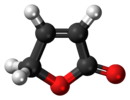2-Furanone
|
|
|||
| Names | |||
|---|---|---|---|
|
IUPAC name
5H-furan-2-one
|
|||
| Other names
furan-2-one, γ-crotonolactone, butenolide
|
|||
| Identifiers | |||
|
3D model (JSmol)
|
|||
| ChEBI | |||
| ChemSpider | |||
| ECHA InfoCard | 100.007.128 | ||
| KEGG | |||
| MeSH | butenolide | ||
|
PubChem CID
|
|||
|
|||
|
|||
| Properties | |||
| C4H4O2 | |||
| Molar mass | 84.07336 | ||
| Density | 1.185 g/cm3, liquid | ||
| Melting point | 4 to 5 °C (39 to 41 °F; 277 to 278 K) | ||
| Boiling point | 86 to 87 °C (187 to 189 °F; 359 to 360 K) 12 mm Hg | ||
|
Except where otherwise noted, data are given for materials in their standard state (at 25 °C [77 °F], 100 kPa).
|
|||
|
|
|||
| Infobox references | |||
2-Furanone is a heterocyclic organic compound. It is also known as γ-crotonolactone (GCL), as it is formally the lactone derived from γ-hydroxyisocrotonic acid. The chemical is colloquially called "butenolide", and is the parent structure for the butenolide class of compounds. It is a colourless liquid.
2-Furanone is prepared by oxidation of furfural:
It exists in equilibrium with the tautomer 2-hydroxyfuran, which serves as an intermediate in the interconversion between the β- and α-furanones. The β form is the more stable. The interconversion is catalyzed by base.
2-Furanones can be converted to furans by a two-step process of reduction followed by dehydration.
...
Wikipedia


